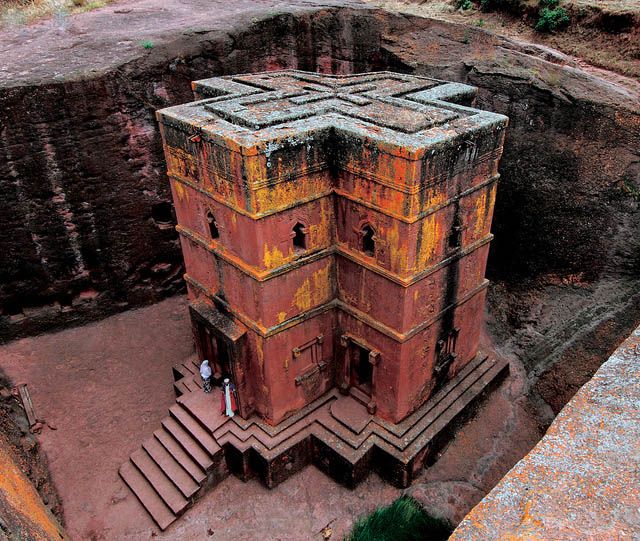Ethiopia, a country steeped in history and rich in cultural heritage, is home to some of the most extraordinary architectural feats in the world: the rock-hewn churches. These ancient structures, carved directly into the rugged landscapes, are a testament to the skill, devotion, and ingenuity of their creators. Here’s why these remarkable churches should be on every traveler’s itinerary.
The Majesty of Lalibela: The New Jerusalem
Lalibela, often referred to as the “New Jerusalem,” is the most famous site for rock-hewn churches in Ethiopia. Constructed in the 12th and 13th centuries during the reign of King Lalibela, these churches were intended to be a New Jerusalem for those who could not make the pilgrimage to the Holy Land.
What to See:
- Bete Giyorgis (Church of St. George): The most iconic of Lalibela’s churches, Bete Giyorgis is carved in the shape of a cross and is renowned for its perfect proportions and spiritual ambiance. It’s often described as the eighth wonder of the world.
- Bete Medhane Alem: This is the largest monolithic church in the world. It is believed to be a copy of St. Mary of Zion in Axum and houses the Lalibela Cross.
- Bete Maryam: Known for its beautiful interior frescoes and carvings, this church is dedicated to the Virgin Mary and is one of the oldest in Lalibela.
Why It’s Great:
- Architectural Marvel: The precision and skill required to carve these churches directly into the rock, creating not just external facades but also detailed interiors, is astounding.
- Spiritual Atmosphere: Lalibela is a living, breathing place of worship. Pilgrims flock here, and the churches are still in use today, allowing visitors to witness vibrant religious practices.
- Historical Significance: These churches are a UNESCO World Heritage Site and represent a significant period in Ethiopian history, reflecting the religious and cultural zeitgeist of medieval Ethiopia.
The Tigray Region: Hidden Gems in the Mountains
The Tigray Region in northern Ethiopia is home to hundreds of lesser-known rock-hewn churches, often perched on dramatic cliffs and hidden in rugged mountains.
What to See:
- Abuna Yemata Guh: Accessible only by a challenging climb, this church is carved into a sheer cliff face. The climb involves scaling vertical rock faces and crossing narrow ledges, but the view and the beautifully painted interiors are worth the effort.
- Debre Damo: Only accessible by climbing a rope up a sheer cliff, this monastery is one of the oldest and most isolated in Ethiopia. It’s known for its ancient manuscripts and well-preserved traditions.
- Wukro Chirkos: Easier to access than some of the more remote churches, Wukro Chirkos offers stunning carvings and a deep sense of history.
Why It’s Great:
- Adventurous Access: The journey to many of these churches is as awe-inspiring as the churches themselves, involving hikes, climbs, and traverses through breathtaking landscapes.
- Secluded Serenity: These churches are less visited than those in Lalibela, offering a peaceful and often solitary experience for the intrepid traveler.
- Unique Art and Architecture: Each church has its own unique style, with intricate carvings, frescoes, and layouts that reflect the diverse influences and creativity of their builders.
The Historical City of Axum
Axum, an ancient city and former capital of the Aksumite Empire, is another key site with significant religious structures, including some rock-hewn churches.
What to See:
- St. Mary of Zion: Believed to house the Ark of the Covenant, this church complex is one of Ethiopia’s most sacred sites. The nearby rock-hewn churches, though less famous than those in Lalibela, are equally fascinating.
Why It’s Great:
- Rich History: Axum is considered the cradle of Ethiopian civilization, with a rich tapestry of legends and historical artifacts.
- Religious Importance: It remains a major pilgrimage site for Ethiopian Orthodox Christians, providing a deep cultural and spiritual context to your visit.
Tips for Visiting Ethiopian Rock-Hewn Churches
- Prepare for Physical Challenges: Some churches, especially in Tigray, require climbing and hiking. Wear appropriate footwear and be prepared for a physical workout.
- Respect Local Customs: These sites are active places of worship. Dress modestly, remove your shoes before entering churches, and be respectful of local religious practices.
- Hire a Guide: Local guides can provide invaluable insights into the history, architecture, and religious significance of the churches.
- Plan Ahead: Some churches are in remote areas with limited accessibility. Plan your visit in advance and consider hiring local transportation to reach these sites.
Conclusion
The rock-hewn churches of Ethiopia are more than just architectural wonders; they are sacred sites that offer a profound glimpse into the country’s spiritual and cultural heritage. From the iconic churches of Lalibela to the hidden treasures of Tigray and the historical significance of Axum, these landmarks provide an unforgettable journey into Ethiopia’s past and present. Whether you’re a history buff, an adventure seeker, or a spiritual pilgrim, the rock-hewn churches of Ethiopia are a must-see destination that promises to inspire and awe.
Join 900+ subscribers
Stay in the loop with everything you need to know.

